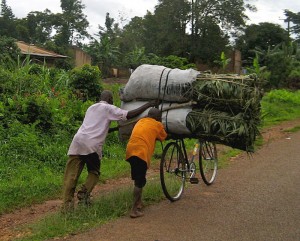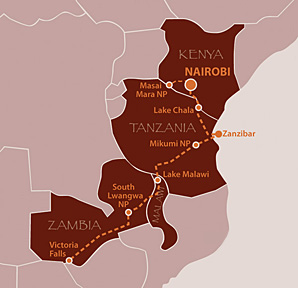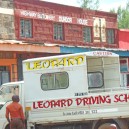Full-length Self Drive Safari Itinerary
(Click here for Dr. Livingstone Safari tour details)
Day 1: David Sheldrick Elephant Orphanage and Karen Blixen Museum
We start our journey on the outskirts of Kenya’s vibrant Capital city, Nairobi. We take some time getting to know our vehicles and the rest of the group before visiting Karen Blixen Museum and stopping at a shopping mall to stockup on snacks and any essentials.
Karen Blixen’s home has been converted into a museum. Karen Blixen lived in this house from 1914 to 1931 when she returned to Denmark permanently. “Out of Africa”, starring Meryl Streep and Robert Redford was filmed in this original home as they depicted and relived Karen Blixen’s and her lover Denys Finch-Hatton’s life in Kenya.
Driving Distance: 70kms
Meals: Breakfast, Dinner
Accommodation: The Castle on Champagne Ridge
Day 2 and 3: Masai Mara Game Reserve
We bid farewell to the hustle and bustle of the city and make our way toward the 7th Natural Wonder in the World – Masai Mara Game Reserve.
The drive takes us along the top of the escarpment overlooking the Great Rift Valley before descending to the plains of Masai Land to the Masai Mara. If clear we will stop at the top of the escarpment for a chance to take some photos and maybe buy a Masai blanket from one of the many curio shops dotted along the road.
We arrive at the gates in the afternoon just in time for a late afternoon game drive, as we make our way to our camp we will hopefully spot elephant, lion, zebra, gazelle, reedbuck, topi, giraffe, and cheetah before reaching our night stop and setting up camp for the evening.
WHAT OUR CUSTOMERS SAY…
We had a marvellous time. Saw lots of the animals we were interested to see. Experienced a lot of the pleasures and terrors of Africa that you referred to in your arrival briefing. And enjoyed the company immensely. We were constantly impressed and appreciative of the hard work that the crew put in right throughout the trip, and we’d want to pay special tribute to their skills as key ingredients for our success. The meticulous planning of the detail of the trip was also very evident.
The following day we have a full day to explore this wondrous game reserve.
The Masai Mara is Kenya’s most famous park; bordering Tanzania and the Serengeti; it boasts the famous Migration which sees 2 million wildebeest and zebra closely followed by predators move from the Serengeti National Park to the Masai Mara National Park.
We spend the day game viewing at leisure, as you have your own vehicle you can take your time, stopping to watch a plethora of wildlife.
At night we camp falling asleep to the sounds of Africa.
Driving Distance: Approx. 220 kms plus game driving
Meals: Breakfast, lunch and dinner
Accommodation: Glamping
Day 4: Champagne Ridge, Rift Valley
We spend the morning game driving through the famous Masai plains before departing the reserve and making our way to the home of Debs and Thiemo, AES directors, on the edge of Great Rift Valley in Kajiado County. This rural retreat is in the heart of Masai land, surrounded by acacia trees, resident herds of wildlife and Masai families’ still living traditional ways.
Debs and Thiemo’s place is totally self-sufficient, the home and guest house are powered entirely by clean alternative energies – wind and solar. Clean water is caught from the roofs and stored in undercover tanks. Debs and Thiemo’s home is also the base of their community project Napenda Solar Community a project to connect rural homes to solar power.
This part of Kenya is untouched by tourists, as we drive along dirt roads we feel like we truly are in the heart of Africa.
We enjoy dinner together while watching the sun set over the Rift Valley.
Driving Distance: Approx. 220 kms plus game driving
Meals: Breakfast, lunch, dinner
Accommodation: The Castle on Champagne Ridge
Day 5: Amboseli National Park (driving distance approx. 200kms plus game driving)
Departing our rural retreat we drive on dirt backroads to Amboseli National Park. Gazetted in 1974 it is just short of 400 square kilometers in size. Although not a very large park it boasts both stunning scenery and an abundance of wildlife. Most famous for large herds of elephant, zebra, giraffe and predators as Mt Kilimanjaro provides a dramatic backdrop at its imposing 5,985m.
We spend the afternoon game driving at leisure before setting up camp.
Meals: Breakfast, lunch and dinner
Accommodation: Camping
Day 6: Slopes of Mt Kilimanjaro

The area around Mt Kilimanjaro is littered with lakes and waterfalls offering amazing clean water sources for coffee farms
We enjoy an early morning game drive before departing Amboseli National Park and Kenya as we enter Tanzania. Our first stop in Tanzania is on the slopes of Mt Kilimanjaro in the small village of Marangu.
Marangu Hotel and Campsite is the perfect spot to sit back and enjoy views of Mt Kilimanjaro and take a walk to one of the many waterfalls or experience a tour of one of local coffee farms.
Driving Distance: Approx. 100 kms
Meals: Breakfast, lunch and dinner
Accommodation: Camping
Day 7 and 8: Pangani River and Dar Es Salaam
We have a relaxing morning before heading off on the next leg of our journey to Dar Es Salaam or “Haven of Peace” in Kiswahili, the commercial Capital of Tanzania and the base from where we will explore the World famous spice island of Zanzibar. It takes us 2 days to arrive in Dar es Salaam.
Driving Distance: Approx. 190 kms and approx 400kms
Meals: Breakfast, lunch and dinner
Accommodation: Camping
Day 9, 10 and 11: Zanzibar
We leave the vehicles in Dar es Salaam and make our way by boat to Zanzibar. The boat arrives in Stone Town – a classic Arabic old city, with narrow cobble stoned streets, sweet smell of spices floats through the air, and the local mosque hums in the background. At sun-down the plaza changes form and as the sun disappears over the Indian Ocean, the Plaza comes alive with the smell of barbecuing fresh seafood, colorfully dressed women mix dough in preparation to make Zanzibar pizzas and the men stand around talking politics. For the true Zanzibar experience a visit and a meal in the plaza is an absolute must.
Based in Stone Town we tour nearby spice plantations and spend some time taking in the vibrant atmosphere of this bustling yet humble historical town. You choose how to fill your free time, maybe go diving or snorkelling in the barrier reef, swim with dolphins, take a boat ride to Prison Island (Changuu Island) to socialise with near extinct Aldabra giant tortoises (they can weigh up to 200kg each), go on a walking tour of Stone Town, shop until you drop at the markets, explore historic buildings still in their original condition.
We spend a few days to relax and enjoy.
Meals: Breakfast
Accommodation: Hotel
Day 12 and 13: Mikumi National Park and Baobab Valley
We return to Dar es Salaam for an overnight stop.
Leaving Dar es Salaam behind us we head west through Mikumi National Park and reach the border of Malawi. Driving through Mikumi National Park it is not uncommon to have to stop on the main highway to give way to herds of Elephants or zebra or a pride of lions crossing. We continue to an ancient valley filled with Baobab trees on the edge of the Udzungwa Mountains. Arriving in the afternoon there is plenty of time to explore the area by foot, spotting numerous birds species, and a variety of plant species growing amongst the Baobab trees.
The Baobab tree is incredibly important to many tribes as it is known as the “tree of life”. The Baobab can provide shelter, clothing, food and water. The bark is fire resistant and is used to make clothing and rope, the leaves are used as condiments and medicines, the fruit is edible and full of vitamin C; the tree can store thousands of litres of water which is tapped during drought; the trunk is often hollow offering shelter.
We spend the night at a quaint rustic campsite on the edge of the great Ruaha river.
Driving Distance: Approx. 400 kms
Meals: Breakfast, lunch and dinner
Accommodation: Camping

Our guided self drive expeditions gets you closer to the action than any other style of Africa travel.
Day 14 and 15: Farmhouse, Iringa and Mbeya
We continue our journey through some of Tanzania’s prime farming areas before crossing the border and entering Malawi. Approximately 100kms before the border to Malawi we begin to descend from the highlands to the low lands and finally to the shores of Lake Malawi.
Driving Distance: Approx. 175kms and 330kms
Meals: Breakfast, lunch and dinner
Accommodation: Camping and hotel
Day 16 and 17: Chitimba beach and Livingstonia
Lake Malawi with its beautiful beaches and coves not only gave the country its name it also covers one third of the county’s surface. We make our way along the Lake stopping at idyllic spots for some time to chat to the locals and watch local craftsmen carve Malawi chairs.
Our first stop in Malawi is on the shores of Lake Malawi in the small fishing village of Chitimba; a small friendly relaxed place.
From Chitimba you have the option to take a day trip to Livingstonia, the road to get there is narrow and steep with plenty of switchbacks, an exhilarating test of Land Rover and driver! Livingstonia, originally a Mission established in 1894 and named after David Livingstone as a tribute to his work and dedication to Missionary work in Africa. Today Livingstonia has gradually developed into a small town but the buildings are still reminiscent of the period. The Mission station is perched 800m above Lake Malawi and offers some of the most spectacular views of Africa in Malawi.
Livingstonia became known as a scholars hub for the Tumbuka people who were open to Western ideas. Many graduates ended up working in neighbouring countries in influential positions.
Livingstonia is a living museum. The town is architecturally Scottish and many buildings are protected. The mission is still in existence today and houses “Stone House”, a museum that records David Livingstone’s adventures and history of missionaries. The local church has a stained glass window of Livingstone, the town has a local market and of course a visit to the Mushroom Farm is a must.
For those up for a bit of a walk you can visit Manchewe Falls, approximately 2 hour walk from Livingstonia. The walk can be strenuous.
Driving Distance: Approx. 180kms and 30kms
Meals: Breakfast, lunch and dinner
Accommodation: Camping
Day 18 and 19: Kande Beach
We bid farewell to Chitimba and Livingstonia and continue driving along the lake shores to Kande Beach. The drive takes us through rubber plantations and if we are lucky enough we will spot young children making soccer balls from the rubber and playing a game of football with their brand new rubber football.
Arriving at Kande Beach by mid afternoon there is plenty of time for those wanting to swim in the cool lake waters. For those interested in rare fish species maybe some snorkeling or diving to spot some of the 800 species of Cichlid fish – a rare fresh water tropical fish species only found in Lake Malawi. Or you can simply take a good book and relax in one of the hammocks around the campsite overlooking the lake.
There is also the opportunity to visit a local primary school and clinic for those interested to see how these facilities may differ from their own back home.
Driving Distance: Approx. 230kms
Meals: Breakfast, lunch and dinner
Accommodation: Camping
Day 20 and 21: Nkhotakota Game Reserve and Lilongwe
Today’s drive hugs the lakeshore before heading into the highlands and through Nkhotakota Game Reserve. As we weave our way through small villages we see the busy lives of the local people from wood carvers to bicycle repair shops to women taking the kernels off cobs of maize. The colorful clothing, huge smiles and hearty waves add to the vibrant friendly atmosphere that makes Malawi such a special country.
The scenery as we drive through Nkhotakota Game Reserve is breath taking as we travel through rain forest and grasslands; if we are lucky we may spot Fish Eagles and Palm Nut Vultures souring above while baboons and antelope feast on the sweet grass, nuts and seeds.
We make our way toward the Capital of Malawi, Lilongwe.
Driving Distance: Approx. 258kms
Meals: Breakfast, lunch and dinner
Accommodation: Camping
Day 22 and 23: South Luangwa
South Luangwa National Park is Zambia’s best game park boasting the richest concentration of wildlife of any park in Africa. South Luangwa National Park is famous for leopard, lion, puku, eland, crocodiles, hyena, Lichtensteins hartebeest as well as a few animals unique to the Luangwa valley like Thornicrofts giraffe, Cooksons wildebeest and Crawshays zebra. It is one of the few parks where night game drives are possible and we take the opportunity in one of the camp vehicles with heavy duty spot lights to spot nocturnal animals. If we are lucky we will see leopard, aardvark, hippos out of the water grazing, cervel cats, caracals and other nocturnal animals.
The campsite where we stay is situated on the banks of the Luangwa River – a natural fence separating the campsite from South Luangwa National Park. It is not unusual for Elephants to wander into camp at breakfast time to check-out the breakfast menu; be warned Kellogg’s Cornflakes are one of their favorite foods and they are not shy in helping themselves!
A spectacular park situated in a spectacular part of Africa.
Driving Distance: Approx. 130kms
Meals: Breakfast, lunch and dinner
Accommodation: Camping
Day 24 and 25: Lusaka
We make our way toward Lusaka, the Capital of Zambia. The drive between South Luangwa and Lusaka takes us through farming areas of Zambia. Some of the most popular produce to farm in this part of the country is cotton, maize, sunflowers, and tobacco.
Lusaka, a once sleepy town, has been transformed into a major city thanks to the increase in global Copper prices – copper being one of Zambia’s prime exports. Lusaka now boasts shopping malls, major supermarkets, and designer clothing stores to name a few. We pass through this city on our way to Livingstone and the famous Victoria Falls
Driving Distance: approx. 450kms and 250kms
Meals: Breakfast, lunch and dinner
Accommodation: Camping
Day 26 and 27: Livingstone and Victoria Falls
“Scenes so lovely must be gazed upon by angels in their flight” said David Livingstone on 16 November 1855 when, being the first European, set eyes upon the Waterfall and promptly named them Victoria Falls as a tribute to Queen Victoria.
The Zambian’s call the Falls Mosi-oa-Tunya literally meaning “Smoke that Thunders” due to the noise and misty spray that can be seen for miles.
Victoria Falls is not the only attraction in Livingstone. For those wanting some adventure there is microlighting, helicopter rides over the falls, walking with lions, and rhino trekking. For those after a more subdued time in Livingstone there are sunset cruises, Livingstone Museum home to original letters and diary entries from David Livingstone.
Livingstone is where we will spend the last 2 nights of our Africa adventure, having driven some 4500 kms through 4 countries we hang up our Land Rover keys. On our final night we enjoy watching the sun set over the Zambezi River chatting and laughing about our adventures, the highlights and the unforgettable memories that we will take home and treasure for a very long time.
Driving Distance: Approx. 500kms
Meals: Breakfast
Accommodation: Hotel/Lodge













































